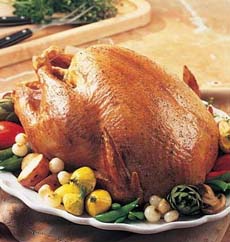 Brine a turkey for moister, more tender meat. Photo courtesy iGourmet. Brine a turkey for moister, more tender meat. Photo courtesy iGourmet.
|
JOHNNY GNALL is a chef and writer based in San Francisco.
|
|
November 2011
|
 |
Turkey Brine Recipes
Page 2: Flavoring The Brine
This is Page 2 of a two-page article. Click on the link below to go to Page 1.
Add Your Favorite Flavors To The Brine
Just as with marinades, brines can become the “secret sauce” of the cook. Think of your favorite flavors, then add them to the brine. We’ll start you with this list of turkey brine recipe ideas:
- Juice Brine. Omit the sugar and substitute half of the water for apple or orange juice, and your turkey will take on a fruity sweetness. Try lemon, grapefruit or yuzu juice for citrus notes.
- Aromatic Seasoning Brine. We like to a handful of szechuan peppercorns, 10 pieces of star anise, a stick of cinnamon (broken in half) and 15 cloves. These aromatic and bold seasonings are unmistakable and add a fresh, but surprisingly subtle, flavor to the Thanksgiving turkey.
- Ginger-Garlic Brine. Add a cup of coarsely-grated fresh ginger root and 10 crushed garlic cloves—two popular flavors that are sure to be crowd-pleasers.
- Sage, Rosemary & Thyme Brine. Add a quarter cup of dried rosemary, a quarter cup of dried sage, and a quarter cup of dried thyme for a savory, herbaceous brine. These herbs will most likely end up in your stuffing as well; if so, the subtly-herbed turkey will complement it nicely.
- Hot Chile Brine. Add some roughly-chopped chiles to your brine. The amount and type of chili will depend on your heat preference, but a good start would be one Serrano pepper, seeds and all. This will add a touch of heat to your turkey without going over the top.
The Final Steps To Brining
Once you have the flavored brine, add it to the brining bag and submerge the turkey in it completely. Set it somewhere cold—the refrigerator or a cooler with ice—for 2 to 24 hours. If the temperature outside is cold but not freezing, you can park it in the garage.
- Eliminate as much air as possible from the bag for best results.
- If you can’t entirely submerge the turkey at once, rotate the bag every few hours to ensure the bird is evenly brined.
- Before cooking, rinse the bird thoroughly, inside and out, or it will be salty. This is very important.
- Then cook the turkey as you normally would. You will need little to no seasoning beyond what you put in your brine, so adjust any rubs or bastes accordingly (i.e., hold the salt).
You can change up your brine seasonings, making every Thanksgiving (or any other day you happen to roast a turkey) a chance to try something new.
Just make sure to be careful and deliberate with your salt; everything else is yours to explore!
Go To The Article Index Above

|




